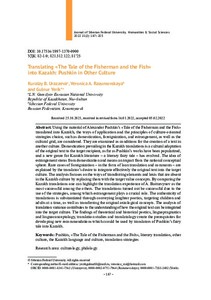Показать сокращенную информацию
Translating «The Tale of the Fisherman and the Fish» into Kazakh: Pushkin in Other Culture
| Автор | Urazaeva, Kuralay B. | en |
| Автор | Razumovskaya, Veronica A. | en |
| Автор | Yerik, Gulnur | en |
| Автор | Уразаева, К. Б. | ru_RU |
| Автор | Разумовская, В. А. | ru_RU |
| Автор | Ерик, Г. | ru_RU |
| Дата внесения | 2022-03-10T06:37:46Z | |
| Дата, когда ресурс стал доступен | 2022-03-10T06:37:46Z | |
| Дата публикации | 2022-02 | |
| URI (для ссылок/цитирований) | https://elib.sfu-kras.ru/handle/2311/145354 | |
| Аннотация | Using the material of Alexander Pushkin’s «Tale of the Fisherman and the Fish» translated into Kazakh, the ways of application and the principles of culture-oriented strategies choice, such as domestication, foreignization, and estrangement, as well as the cultural grid, are considered. They are examined as conditions for the creation of a text in another culture. Domestication prevailing in the Kazakh translations is a cultural adaptation of the original text to the target recipient, as far as Pushkin’s works have been popularized, and a new genre for Kazakh literature – a literary fairy tale – has evolved. The idea of estrangement stems from domestication and means an impact from the national conceptual sphere. Rare cases of foreignization – in the form of loan translation and comments – are explained by the translator’s desire to integrate effectively the original text into the target culture. The analysis focuses on the ways of transferring elements and lexis that are absent in the Kazakh culture by replacing them with the target value concepts. By comparing the Kazakh translations one can highlight the translation experience of A. Baitursynov as the most successful among the others. The translations turned out be successful due to the use of the strategies, among which estrangement plays a crucial role. The authenticity of translations is substantiated through conveying laughter poetics, targeting children and adults at a time, as well as transferring the original axiological concepts. The analysis of translation variance contributes to the understanding of how the original text can be integrated into the target culture. The findings of theoretical and historical poetics, linguopragmatics and linguoconceptology, translation studies and translatology create the prerequisites for developing new recommendations which ccould be used by translators of Pushkin’s fairy tale into Kazakh | en |
| Аннотация | На материале казахских переводов «Сказки о рыбаке и рыбке» А. Пушкина рассматриваются способы применения и принципы выбора культуро-ориентированных стратегий, таких как доместикация, форенизация и остранение, а также культурная решетка. Они исследованы как условия создания текста в другой культуре. Преобладающая в казахских переводах доместикация обоснована как адаптация текста оригинала к восприятию адресата перевода, обусловленная популяризацией творчества Пушкина и освоением нового для казахской литературы жанра – литературной сказки. Понятие остранения обосновано как расширение доместикации и результат влияния национальной концептосферы. Немногочисленность случаев форенизации – в виде кальки и примечаний – объясняется стремлением переводчика к эффективной интеграции текста оригинала в культуру языка перевода. Предметом анализа стали способы передачи отсутствующих в казахской действительности реалий и лексических единиц посредством замены их ценностными понятиями родной культуры реципиента. Сопоставление казахских переводов – с позиции парадоксальной природы сказки Пушкина – позволяет выделить художественный опыт А. Байтурсынова среди других переводов. Успех переводов объясняется использованием рассмотренных стратегий и особым местом остранения среди них. Понятие аутентичности переводов сказки Пушкина обосновано в аспекте передачи смеховой поэтики, адресованности ребенку и взрослому, а также аксиологических концептов оригинала. Анализ переводческой дисперсии также позволяет дополнить представление о факторах интеграции оригинала в культуру языка перевода. Применение результатов теоретической и исторической поэтики, лингвопрагматики и лингвоконцептологии, переводоведения и транслатологии создает предпосылки для рекомендаций переводчикам сказки Пушкина на казахский язык | ru_RU |
| Язык | en | en |
| Издатель | Сибирский федеральный университет. Siberian Federal University | en |
| Тема | Pushkin | en |
| Тема | «The Tale of the Fisherman and the Fish» | en |
| Тема | literary translation | en |
| Тема | other culture | en |
| Тема | the Kazakh language and culture | en |
| Тема | translation strategies | en |
| Тема | Пушкин | ru_RU |
| Тема | «Сказка о рыбаке и рыбке» | ru_RU |
| Тема | художественный перевод | ru_RU |
| Тема | другая культура | ru_RU |
| Тема | казахский язык и культура | ru_RU |
| Тема | стратегии перевода | ru_RU |
| Название | Translating «The Tale of the Fisherman and the Fish» into Kazakh: Pushkin in Other Culture | en |
| Альтернативное название | Казахские переводы «Сказки о рыбаке и рыбке»: пушкинский текст в другой культуре | ru_RU |
| Тип | Journal Article | en |
| Контакты автора | Urazaeva, Kuralay B.: L.N. Gumilyov Eurasian National University Republic of Kazakhstan, Nur-Sultan; ORCID: 0000-0001-8341-7562 | en |
| Контакты автора | Razumovskaya, Veronica A.: Siberian Federal University Russian Federation, Krasnoyarsk; veronica_raz@hotmail.com; ORCID: 0000-0002-0751-7964 | en |
| Контакты автора | Yerik, Gulnur: L.N. Gumilyov Eurasian National University Republic of Kazakhstan, Nur-Sultan; yerikgulnur88@mail.ru; ORCID: 0000-0001-7283-2402 | en |
| Контакты автора | Уразаева, К. Б.: Евразийский Национальный университет Республика Казахстан, Нур-Султан | ru_RU |
| Контакты автора | Разумовская, В. А.: Сибирский федеральный университет Российская Федерация, Красноярск | ru_RU |
| Контакты автора | Ерик, Г.: Евразийский Национальный университет Республика Казахстан, Нур-Султан | ru_RU |
| Страницы | 187–203 | ru_RU |
| DOI | 10.17516/1997-1370-0900 | |
| Журнал | Журнал Сибирского федерального университета. Гуманитарные науки. Journal of Siberian Federal University. Humanities & Social Sciences 2022 15 (2) | en |

